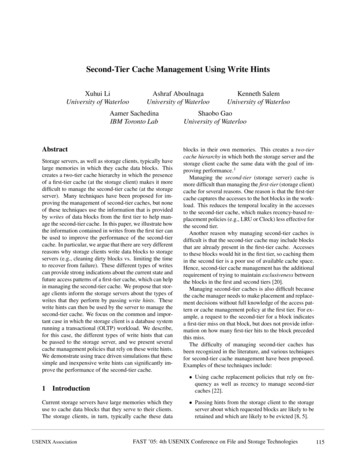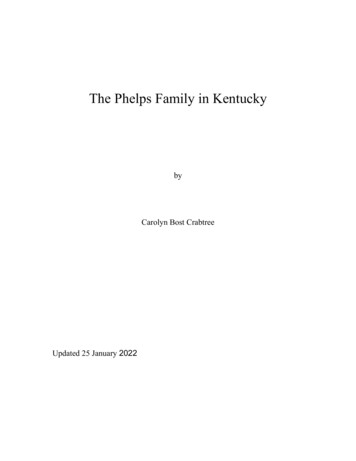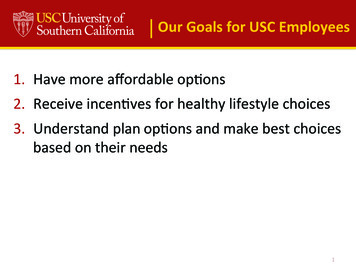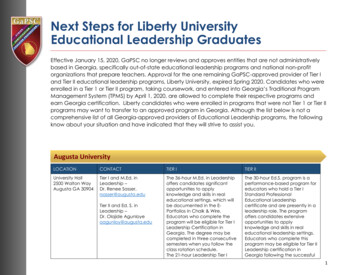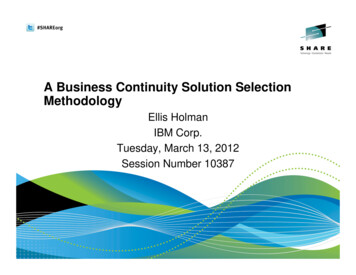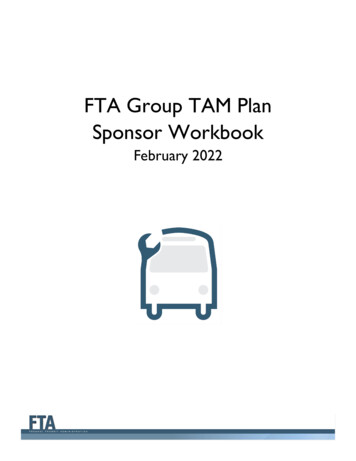
Transcription
Tierfor members participatingprior to September 1, 2008Tier 11This guide is a companion publication to KPPA’s Summary PlanDescription. For a comprehensive overview of our plans, refer tothe Summary Plan Description published at https://kyret.ky.gov.
TIER 1 PLAN GUIDEKPPA currently operates three different pension benefit tiers within our defined benefit plans:Tier 1 members have a participation date prior to September 1, 2008.The General Assembly passed House Bill 1 during the 2008 special legislative session. House Bill 1established different criteria for retirement eligibility, the final compensation calculation, and benefitfactors. Tier 2 members have a participation date of September 1, 2008 through December 31, 2013.During the 2013 legislative session, Senate Bill 2 was enacted, creating Tier 3 benefits for memberswith a participation date on or after January 1, 2014.This guide explains benefits for Tier 1 members who began participating prior to September 1, 2008, beforeHouse Bill 1 and Senate Bill 2 changes were effective.Contact UsOnline ResourcesDavid L. EagerExecutive Directorkppa.mail@kyret.ky.govOffice HoursMonday - Friday 8:00am - 4:30pmhttps://kyret.ky.govIncoming email is not secure. Email should only beused for general questions.1-502-696-8800 or 1-800-928-4646Educational materials and forms are available online.https://www.facebook.com/kyretirementLike our page so we show up in your news feed.https://myretirement.ky.gov1260 Louisville RoadFrankfort, KY 40601Access your account online. See page 23 for more info.TABLE OF CONTENTS0310180312220414230516230617My Retirement SystemWhat is the Tier 1 Plan?My Retirement AccountManaging My AccountWhen Can I Retire?How is My Benefit Calculated?Can I Purchase Additional Service Credit?What are My Payment Options?Basic Payment Option ExamplesGood to KnowAccessing Benefits InfoMy Online AccountWe’re Here for YouCan I Leave My Benefit to Someone?This guide is a companion publication to KPPA’s Summary Plan Description. For a comprehensiveoverview of our plans, refer to the Summary Plan Description published at https://kyret.ky.gov.Tier 12
My Retirement SystemKentucky Public Pensions Authority (KPPA) provides retirement benefits for more than 400,000 state and localgovernment members. The three systems operated by KPPA are 401(a) plans. A 9-member board of trustees isresponsible for the governance of the County Employment Retirement System (CERS). Another 9-member board oftrustees called the Kentucky Retirement Systems (KRS) is responsible for the governance of the Kentucky EmployeesRetirement System (KERS) and the State Police Retirement System (SPRS). KPPA is an administrative entitycomprising the office with counselors and professional staff responsible for the daily operations of the systems.Kentucky EmployeesRetirement SystemKERSStateemployeesCERSest1956SPRS401(a) Planest1958Local governmentand classifiedschool boardemployeesUniformed statepolice officersCounty EmployeesRetirement SystemState PoliceRetirement Systemest1958Kentucky Administrative Regulations Title 105Copies may be available at public libraries, oron the LRC website http://lrc.ky.gov.What is the Tier 1 Plan?Tier 1 is one of three tiers within our defined benefit pension plan. This benefit tier is for members who beganparticipation prior to September 1, 2008. Tier 1 is a defined benefit plan because it uses a specific formula todetermine benefits and the assets of the plan remain in a single investment pool.Who is eligible?All regular full-time employees who began participation in one of the systems operated by KPPA prior toSeptember 1, 2008 contribute to the Tier 1 plan. Your participation date is when you began paying contributionsand earning service credit with a state-administered retirement system. This date may be different from the dateyou were hired.Your participation in the plan is mandatory unless you are a non-participating employee. Employmentclassifications that are non-participating include part-time, seasonal, temporary, probationary (CERS only), interim,emergency, and independent contractors.Your participation date can change the level of benefits to which you are entitled, health insurance eligibility, and your eligibility topurchase service.3Tier 1
How does it work?Benefits are funded through three sources:1. Employee contributions deducted from a member’s creditable compensation.2. Employer contributions paid by each participating agency.3. Return on investments.Kentucky law defines creditable compensation. For more info, refer to our Summary Plan Description at https://kyret.ky.gov.When a member is eligible to retire, the benefit is calculated based on a formula:Final CompensationBenefit FactorxYears of ServicexMy Retirement AccountHow much do I contribute?Members of the Tier 1 plan contribute a set percentage of their salary each month to their own account as requiredby Kentucky law:5%8%of creditablecompensationof MembersHow much does my employer contribute?The employer contribution rate is set annually by the CERS and KRS Boards of Trustees based on an actuarialvaluation. The employer contributes a set percentage of the member’s salary. KERS and SPRS rates are subject toapproval by the General Assembly through the adoption of the biennial Executive Branch Budget. The CERS Boardsets CERS employer contribution rates unless altered by legislation. Employer contribution rates are publishedonline at https://kyret.ky.gov. Employer contributions are not deposited to the member’s individual account.Does my account earn interest?Prior to retirement, a member’s account earns a guaranteed amount of interest at the end of each fiscal year.Interest is credited to your account based on your account balance as of June 30 of the prior fiscal year. For Tier 1members, the interest paid is set by the CERS and KRS Boards and will not be less than 2%.How are the contributions invested?The CERS and KRS Boards and its investment professionals are responsible for investment decisions. The Boardsestablish clearly defined investment policies, objectives and strategies for both the pension and insurance portfolios.The investment policies and detailed monthly investment performance reports are published on our website athttps://kyret.ky.gov.The Boards are governed by the “Prudent Person” rule and must invest solely in the interests of members and their beneficiaries, impartiallyand with a good faith interpretation of the law.Tier 14
Managing My AccountWhat if I leave my job?You have three options if you leave your job:WithdrawyouraccountKeepyourmoneyat KPPARetire ifeligibleOption 1: Keep your money at KPPAYour account will continue to earn interest on the accumulated account balance and you can retire when youbecome eligible based on age.If you change jobs and your new employer is a participating employer, you will contribute to your existing accountand continue to accrue service credit.Option 2: Withdraw your accountMembers are eligible for a refund of the member contributions plus any accumulated interest. Members do notreceive a refund of any employer contributions.Refunds from your account may be paid directly to you or can be rolled over to another qualified retirement plan.If you elect to receive a direct payment, KPPA is generally required to withhold 20% for federal income taxes. Theamount withheld is not a penalty tax and will apply toward your federal tax liability for the year in which the refundis issued. Additional taxes due to age or other factors may apply if you choose to receive a direct payment of yourrefund.If you go to work for a participating employer at a later date, you may be eligible to purchase your refundedservice. However, the purchase will not reestablish your original participation date which determines the benefittier you are in; you only receive credit for the months of service you purchase.By taking a refund, members forfeit eligibility for future benefits including health insurance and the 5,000 death benefit.Option 3: Retire if you’re eligibleRetirement eligibility is dependent upon your age and years of service. Read more on page 6.5Tier 1
When Can I Retire?Under Tier 1, members may be eligible for a reduced or unreduced benefit. The qualifications are differentdepending on your type of service (hazardous vs nonhazardous).If a hazardous or nonhazardous member who is of normal retirement age has less than four years of service credit, the benefit is calculatedbased on a different formula.NonhazardousMembersThe requirements for an Unreduced Benefit are:Age 65 or olderwith at least1 month ofservice credit.Any age with27 years ofservice credit.The requirements for a Reduced Benefit are:Prior to age 65with at least 25 butless than 27 yearsof service credit.HazardousMembersThe requirements for an Unreduced Benefit are:Age 55 or olderwith at least1 month ofservice credit.Any age with20 years ofservice credit.The requirements for a Reduced Benefit are:Age 55 with atleast 5 years ofservice credit.Age 50 with 15,but less than 20,years ofservice credit.If a member qualifies for a reduced benefit, the amount of reduction depends on the member’s age or years ofservice at retirement.Page 7 explains how the reduction works.If a hazardous or nonhazardous member’s participation date is August 1, 2004 or after, the only purchase types that count towardretirement eligibility are omitted service, recontribution of refund and hazardous conversion.Tier 16
Receiving a Reduced BenefitIf a member qualifies for a reduced benefit, the amount of reduction depends on the member’s age or years ofservice at retirement.For ExampleA nonhazardous member has 25 years of service and is age 55. Ifthe member chooses to retire, the benefit will be reduced to 87%because the member is two years short of reaching 27 years ofservice.87%To use the chart below, determine the number of years the member is short of reaching an unreduced benefit,based on age or service, whichever is less.93.5%87.0%% of Benefit Paid80.5%74.0%67.5%63.0%58.5%54.0%1 Yr49.5%2 Yrs45.0%3 Yrs4 Yrs5 Yrs6 Yrs7 Yrs8 Yrs9 Yrs1 Yr2 YrsYearsUnreduced3 Yrs Away4 Yrs From5 Yrs6 Yrs7BenefitYrs8 YrsBased on Age or Service Whichever is Less10 Yrs9 Yrs10 Yrs7Tier 1
How is My Benefit Calculated?When a member is eligible to retire, the benefit is calculated based on a formula:Final CompensationFiscal year earnings used whencalculating your retirement benefit.Benefit FactorxxSet by state law and vary based on thetype of service and participation date.Years of ServiceYears of service represents your totalservice credit at the time of retirement.FINAL COMPENSATIONFor Tier 1 members, final compensation, or salary average, is determined by dividing the total salaryearned (5-High or 3-High) by the total months worked and then multiplying by twelve to annualize.Nonhazardous MembersHazardous MembersNonhazardous retirements are based on 5-Highfinal compensation. When final compensation isbased on 5-High, it must include 48 months and aminimum of 5 fiscal years. The example below walksyou through the final compensation calculation.Hazardous retirement benefits are based on3-High final compensation. A 3-High finalcompensation must include at least 24 monthsand a minimum of three fiscal years.Fiscal Year5-HighFiscal Year3-HighYear 1 2,6251Year 1 3,6251Year 2 31,29512Year 2 40,00012Year 3 29,79512Year 3 38,50012Year 4 28,29512Total 82,12525Year 5 26,79512Total 118,80549Months 82,125 / 25 months x 12 39,420 118,805 / 49 months x 12 29,095Benefits are calculated based on a fiscal year, which begins July 1 and ends June 30.Tier 18Months
For both hazardous and nonhazardous service, the years used do not have to be full (12 month) years. The fiscalyears do not have to be consecutive, although for most members, the last years of employment are generally theyears of highest earnings. Members approaching retirement should plan termination of employment so that thelast day of employment is the last working day of the month. Otherwise, the member’s final compensation may bereduced because of an individual’s final month representing only a partial month’s wages.For fiscal years beginning with 1996-1997, final compensation is limited to the annual compensation limits set by federal law.A member who has hazardous and nonhazardous service will receive two monthly benefits: one for the hazardousand one for the nonhazardous service. In this situation, a member will have a 5-High final compensation for thenonhazardous service and 3-High for the final compensation for the hazardous service.Benefit FactorBenefit factors are set by state law and vary based on the type of service and participation date. The benefitfactors shown below apply to Tier 1 members.KERS NonhazardousCERS Nonhazardous1.97%2.00%If member does not have 13 monthscredit for 1/1/1998-1/1/1999If member began participating on orafter 8/1/2004 and before 9/1/20082.00%2.20%If member has 13 months credit for1/1/1998-1/1/1999If member began participating priorto 8/1/2004HazardousKERS 2.49%CERS 2.50%SPRS 2.50%Only SPRS members and KERS and CERSmembers in an approved hazardous dutyposition are eligible.9Tier 1
How is My Benefit Calculated?Service CreditThe service used to calculate retirement benefits may include:1. Current Service2. Prior Service3. Purchased Service4. Sick Leave ServiceMembers who began participating on or after August 1, 2004 cannot use most service purchase types fordetermining eligibility for retirement benefits, death benefits and insurance benefits at retirement. This applies toall service purchases made by the member or employer with the exception of omitted service, recontribution ofservice refunds, and hazardous conversions as well as service credit for free military and sick leave.Your participation date is when you began paying contributions and earning service credit with a state-administered retirement system.This date may be different from the date you were hired.To earn service credit, a member must work in a regular full-time position, defined as a position that averages 100or more hours per month over a calendar or fiscal year. For local school boards, a regular full-time position is anon-certified position where the employee averages 80 or more hours of work per month over actual days worked.Current ServiceCurrent service is earned as a contributing member. For each month an employer reports wages and contributionsfor regular full-time employment, a member earns one month of service credit.Prior ServicePrior service is all service earned before July 1, 1956 in KERS and July 1, 1958 in CERS and SPRS. There is no costfor this service. A member must have at least 12 months of current service in the same retirement system in orderto use the prior service toward a retirement benefit. Prior service is only credited for months in which the memberworked at least 100 hours.Purchased ServiceThere are more than 30 types of service a participating member may purchase to increase total service credit. Youcan find a list of the most common purchase types on page 12. For a complete listing, refer to our Summary PlanDescription at https://kyret.ky.gov.Most service purchases will not reestablish an earlier participation date.State law outlines the requirements for each purchase type. If you are interested in purchasing service, you shouldcall our office to request an official cost calculation. Please note that the appropriate verification must be filed withKPPA before the purchase cost can be calculated. Please write your Member ID on any documentation you submitto our office.Tier 110
Sick Leave ServiceMost members of KERS and SPRS receive service credit for all unused sick leave at the time of retirement.Participation in the sick leave program is optional for CERS employers. Members of CERS may receive servicecredit for their sick leave at retirement if their employer has adopted the Standard or Alternate sick leave programwith KPPA. CERS members should check with their employer to see what sick leave program is in place.Sick leave is credited based on the member’s unused hours of sick leave and the hours worked per day. Thefollowing chart gives you an idea of how you can receive credit for your sick leave balance at retirement.4 hoursper day6 hoursper day7.5 hoursper day8 hoursper dayServiceCredit44 - 8466 - 12682.5 - 157.588 - 1681 month128 - 168192 - 252240 - 315256 - 3362 months212 - 252318 - 378397.5 - 472.5424 - 5043 months296 - 336444 - 504555 - 630592 - 6724 months380 - 420570 - 630712.5 - 787.5760 - 8405 months464 - 504696 - 756870 - 945928 - 10086 monthsFor an expanded list, please refer to our Summary Plan Description at https://kyret.ky.gov.You only need the minimum hours of sick leave for each range to obtain the indicated months of service.Standard Sick Leave ExampleIf you work 7.5 hours per day, and you have 900 hours of sick leave, you will receive 6 months of service credit. Youwould also receive 6 months of service credit at retirement if you only had 870 hours of sick leave.Alternate Sick Leave ExampleIf you work 8 hours per day, and you have 575 hours of sick leave, you will receive 3 months of sick leave serviceand the money paid to you for your unused sick leave is used in determining your Final Compensation.11Tier 1
Can I Purchase Additional Service Credit?Under Tier 1, there are more than 30 service purchase types available. Below we have listed the most commonpurchase types. If you don’t see your service type here, please refer to the list provided on our website athttps://kyret.ky.gov.On or after August 1, 2004The only service purchases that count toward insurance eligibility are omitted service, hazardous conversion andrecontribution of refunded service.Purchase Types without Service RequirementsRecontribution of Refunded ServiceA member currently participating in one of the state-administered retirement systems who has taken a refundof retirement contributions for previous employment may regain the service lost by paying the amount ofcontributions withdrawn plus interest calculated from the time of withdrawal. This purchase will not reestablishan earlier participation date. The member must work for at least six months to validate the purchase.Verification Required: Information should be on file at KPPA.Summer MonthsA member currently participating in one of the state-administered retirement systems who was contracted bya local school board, university, community action agency, or school for the deaf or blind to work 9, 10, or 11months may purchase up to 3 additional months to complete a full year.Verification Required: Information should be on file at KPPA.Omitted ServiceIf a member was entitled to service credit but was not reported to KPPA, the member may obtain serviceby paying the employee contributions for the period of omitted service. If employee contributions are notreceived within 6 months of notification by KPPA, a participating employee may obtain the service by payingthe employee contributions plus any accumulated interest. Service credit will not be awarded to the member’saccount until KPPA has also received the employer contributions.Verification Required: Form 4225 — or — Personnel FormsPurchase Types with Service RequirementsA member under the age of 65 must have at least 60 months of service credit while a member over the age of 65 must have at least 48months of service credit.Delayed Service (also known as past service)A member may purchase service with an agency that did not participate in systems operated by KPPA but hassince joined. Delayed Service is service worked prior to the date the agency began participating or in the caseof a member who initially rejected membership, service worked from the member’s hire date through his orher election to participate in KPPA.Verification Required: Form 4225Seasonal, Temporary, Emergency, Interim or Part-timeA member may purchase service for time worked for a participating agency in a seasonal, temporary, interim,emergency, or part-time position (more than 100 hours per month).Verification Required: Form 4225 — or — Personnel FormsTier 112
Purchase Types with Service Requirements continuedNon-Qualified Service (also known as air time)Members currently participating and who participated prior to August 1, 2002, may purchase up to 5 years ofservice once they have 15 years of total service in a state administered retirement system. At least 5 of the 15years required for this purchase type must be in KERS, CERS, or SPRS. The Non-Qualified service may not beused for benefit purposes until the member has 20 years of service credit, excluding the Non-Qualified service.Verification Required: Information should be on file at KPPA.Active Duty MilitaryA member may purchase all periods of active duty service with a branch of the Armed Forces. This purchasemay require an honorable or general discharge from service.Verification Required: A copy of your DD-Form 214 for each period of active duty.National Guard/ReservesA member may purchase 1 month of credit for every 6 months served.Verification Required: Most recent Annual Statement of Points.State University ServiceA member may purchase service for certain types of employment with Kentucky’s state-sponsored universitiesprovided they did not participate in a defined benefit plan during employment, and the position held wouldhave qualified as a regular full-time position had the university been a participating department. This purchaseis limited to the University of Kentucky and the University of Louisville since other state-sponsored universitiesparticipate in KERS.Verification Required: Form 4120Approved LeaveA member may purchase service credit for: Approved educational leave, Authorized maternity leave without pay, Approved sick leave without pay, or Approved leave without pay under the Family Medical Leave Act (FMLA) that occurred while workingfor a participating agency.Verification Required: Form 4225 — or — Personnel Forms — or — Letter from agency verifying the period of leave.Federal ServiceA member may purchase service worked as a full time federal employee provided the member withdrew allfunds or did not participate in the Federal Retirement System.Verification Required: Form 4225 — or — Personnel Forms — or — Letter from agency verifying the period of leave.Out-of-State ServiceA member may purchase up to 10 years of service credit for full-time out-of-state public service. To qualify,the service must have been credited in a state- or locally-administered defined benefit retirement plan,other than one for teachers. The member must show that he or she has received a refund or is not eligiblefor a retirement benefit for the period of out-of-state service. For Hazardous Duty: To establish the positionas hazardous duty, the member must submit a copy of the job description for his or her out of state publicservice.Verification Required: Form 4225 — or — Personnel Forms — or — Letter from agency verifying the period of leave.13Tier 1
What are My Payment Options?KPPA offers various payment options so that a retiring member can select a monthly benefit option best suited tohis or her particular retirement needs. The available payment options are listed below.BasicThis option provides a monthly benefit to the member until death. The Basic option does not provide abenefit to the beneficiary after the member’s death. It provides the highest monthly lifetime benefit. If you passaway before receiving an amount equal to your accumulated account balance at the time of retirement, yourbeneficiary will receive any remaining balance of your accumulated contributions (i.e. member contributionsand interest).Life with 10 Years CertainThis option is available for members who are age 75 or younger at retirement. This option guarantees paymentsfor a 120-month period that begins when the member retires. If the member dies before 120 payments havebeen made, the beneficiary will receive the remaining payments. If the member survives past the 120 payments,the same monthly benefit continues to the member for life, but the beneficiary is no longer eligible for benefitsupon the member’s death.Life with 15 Years CertainThis option is available for members who are age 67 or younger at retirement. This option guarantees paymentsfor a 180-month period that begins when the member retires. If the member dies before 180 payments havebeen made, the beneficiary will receive the remaining payments. If the member survives past the 180 payments,the same monthly benefit continues to the member for life, but the beneficiary is no longer eligible for benefitsupon the member’s death.Life with 20 Years CertainThis option is available for members who are age 61 or younger at retirement. This option guarantees paymentsfor a 240-month period that begins when the member retires. If the member dies before 240 payments havebeen made, the beneficiary will receive the remaining payments. If the member survives past the 240 payments,the same monthly benefit continues to the member for life, but the beneficiary is no longer eligible for benefitsupon the member’s death.Survivorship 100%This option guarantees a monthly benefit to the member for the member’s lifetime. If the member dies beforethe beneficiary, the beneficiary is eligible for the same monthly benefit until death.Survivorship 66 2/3%This option guarantees a monthly benefit to the member for the member’s lifetime. If the member dies beforethe beneficiary, the beneficiary is eligible for a monthly benefit equal to 66 2/3% of the member’s monthlybenefit until death.Survivorship 50%This option guarantees a monthly benefit to the member for the member’s lifetime. If the member dies beforethe beneficiary, the beneficiary is eligible for a monthly benefit equal to 50% of the member’s monthly benefituntil death.Tier 114
Pop-UpThis option guarantees a monthly benefit to the member for the member’s lifetime. If the member dies beforethe beneficiary, the beneficiary is eligible for the same monthly benefit until death; however, if the beneficiarydies before the member, the member’s monthly benefit “Pops-Up,” or increases, to the amount under theBasic option. The member’s benefit will also Pop-Up if the member’s beneficiary is a spouse and they becomedivorced.Social Security Adjustment (without survivor rights)A member less than age 62 may elect to take a larger monthly payment until reaching age 62, when they maybe eligible for Social Security. The monthly benefit will be reduced the month following the member’s 62ndbirthday. This option does not affect the amount of Social Security that the member will receive. A beneficiary isnot eligible for benefits if the member dies.Social Security Adjustment (with survivor rights)This option provides the same benefits as the Social Security Adjustment option without survivor rights. Inaddition, it guarantees the same benefit to the beneficiary if the member dies. If the member dies before age62, the beneficiary draws the higher payment until the member would have become age 62. After that, thebeneficiary will receive the same reduced monthly benefit that the member would have received.Actuarial Equivalent RefundThis option provides a one-time lump sum payment to the member that is the actuarial equivalent of the amountthe member would have received if the benefit were paid over 60 months. Carefully consider this option. Thisis a retirement benefit, not a refund of the member’s account. Under this option, the member forfeits all healthinsurance benefits, the death benefit, and any other benefits. The actuarial refund cannot be repaid if themember is later employed with a participating agency. A member may be subject to additional tax penaltiesunder this option.Lump Sum RefundThis option provides a one-time lump sum payment of the member’s accumulated contributions and interest.The one-time payment may be (1) paid directly to the member, minus 20% for federal income tax, or (2) partiallyor directly rolled over to an Individual Retirement Account (IRA) or eligible employer plan. Carefully consider thisoption. Under this option, the member forfeits all health insurance benefits, the death benefit, and any otherbenefits. The refund cannot be repaid if the member is later employed with a participating agency. A membermay be subject to additional tax penalties under this option.Ten Years Certain Option (Hazardous Only)This option provides a monthly payment guaranteed for 120 months to the member, or if the member dies, tothe beneficiary for the remainder of the 120 months. After the 120-month period, the member still retains theinsurance benefit but is no longer eligible for any other benefits. This benefit pays a high monthly amount, butonly for 10 years. After 10 years, this benefit ceases altogether and neither the member nor the beneficiarywill receive further payments. In addition, after the end of the 10 years, there will be no 5,000 death benefitpayment at the time of the member’s death. For this option, the member may name a single person, trust, orestate as beneficiary. This option is only available for Tier One and Tier Two SPRS members or KERSor CERS members in hazardous positions. It is not offered to members who have hazardous andnonhazardous service in the same system, or Tier Three members.15Tier 1
Basic Payment Option ExamplesThe following examples illustrate how the Basic payment option is calculated when a member is eligible to retire.Nonhazardous ExampleJane Doe works in a Nonazardous position for an agency participating in CERS. She is retiring August1 with a final compensation of 29,095 and 27 years of service credit. Her benefit is calculated usingthe retirement formula:Final CompensationBenefit Factor*xMonths of Servicex 29,095Annual Benefit 2.2% 17,282.4327 Years*Jane began participating
Tier 1 is one of three tiers within our defined benefit pension plan. This benefit tier is for members who began participation prior to September 1, 2008. Tier 1 is a defined benefit plan because it uses a specific formula to determine benefits and the assets of the plan remain in a single investment pool. Who is eligible?


